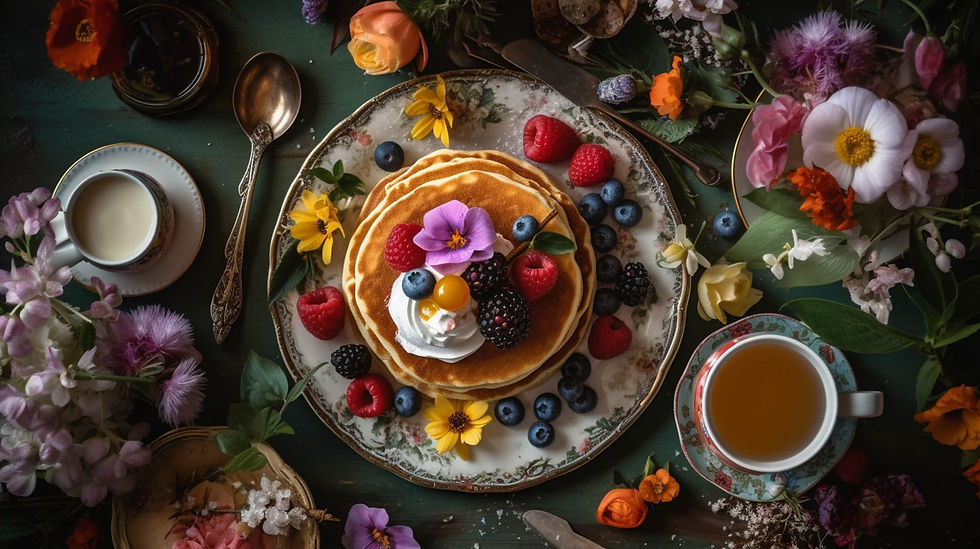Creating Visually Stunning Food Photography for Restaurants and Brands
- Vladislav Kudriavtcev
- May 13, 2023
- 4 min read
In today's visual and social media-driven world, food photography for restaurants and brands is more critical than ever. High-quality, mouth-watering images can grab the attention of potential customers, boost online presence, and ultimately drive sales. This post covers the importance of food photography, essential techniques, and tips for getting started and promoting your business.
Table of Contents:
The Importance of Food Photography for Restaurants and Brands
In today's highly visual and social media-driven world, food photography for restaurants and brands has become more important than ever. High-quality, mouth-watering images can grab the attention of potential customers, boost online presence, and ultimately drive sales. For cookbooks and culinary publications, stunning food photographs can elevate the overall experience and help readers connect with the recipes on a deeper level.

How to Get Started with Food Photography
Selecting the Right Equipment
When it comes to food photography for restaurants and brands, the right equipment can make all the difference. While a high-quality DSLR or mirrorless camera is recommended, many smartphones now have powerful cameras that can produce stunning results. A tripod can help stabilize your shots and ensure crisp, clear images. Additionally, consider purchasing a few lenses to allow for versatility in your photography, such as a macro lens for close-up shots and a wide-angle lens for capturing larger scenes.
Mastering the Basics of Photography
Before diving into the world of food photography, it's essential to have a strong understanding of the basics of photography. Familiarize yourself with essential photography concepts such as aperture, shutter speed, ISO, and white balance. Learn how these settings work together to create well-exposed images and experiment with different combinations to find the best results for your food photography.
Finding Inspiration and Developing Your Style
Developing a unique style is crucial in the competitive world of food photography. To find inspiration, browse the work of successful food photographers, follow food blogs, and study cookbooks and culinary publications. As you develop your style, consider your target audience's preferences and the specific needs of restaurants and brands in your niche.

Essential Food Photography Techniques
Using Natural Light
Natural light is a food photographer's best friend. Take advantage of natural light whenever possible by shooting near a window or outdoors. Soft, diffused light helps create a more appetizing look for food, while harsh artificial lighting can result in unappealing shadows and color casts. If natural light isn't available, consider investing in a softbox or reflector to mimic the look of natural light.
Composition and Styling
Composition is a critical aspect of food photography, as it can make or break an image. Pay close attention to the arrangement of elements within the frame, using techniques such as the rule of thirds and leading lines to create visually appealing images. Food styling is also essential, as it helps showcase the dishes in their best light. Experiment with different props, backgrounds, and garnishes to enhance the visual appeal of your food photography for restaurants and brands.

Editing Your Images
Post-processing is a crucial step in creating stunning food photography. Familiarize yourself with photo editing software such as Adobe Lightroom or Photoshop to enhance the colors, adjust the exposure, and fine-tune your images. Remember, less is more when it comes to editing - the goal is to create natural-looking images that showcase the food in its best light, not to heavily manipulate the scene.
Promoting Your Food Photography Business
Building a Portfolio
A strong portfolio is essential for showcasing your skills and attracting clients. Include a diverse range of images, showcasing various types of dishes, styles, and lighting techniques. A well-rounded portfolio will demonstrate your versatility and expertise, making you a more attractive candidate for restaurants, food and beverage companies, and culinary publications.
Marketing Strategies
To grow your food photography business, you'll need to employ effective marketing strategies. Utilize social media platforms such as Instagram, Facebook, and Pinterest to share your work and connect with potential clients. Additionally, consider creating a blog to share behind-the-scenes insights, tips, and tutorials to establish yourself as an authority in the industry. Networking with other professionals, such as chefs, food stylists, and restaurant owners, can also lead to new opportunities and referrals.
Collaborating with Other Professionals
Collaborating with other professionals in the food industry can help elevate your food photography for restaurants and brands. Working with talented chefs, food stylists, and prop stylists can result in more visually stunning images, while partnering with fellow photographers and bloggers can provide valuable cross-promotion opportunities. Collaboration helps improve your work's quality and expands your professional network and potential client base.
By mastering essential food photography techniques, developing a unique style, and employing effective marketing strategies, you can create visually stunning food photography for restaurants and brands, and ultimately grow a successful food photography business.
Good Food Photography Blogs to Follow:
https://adventuresincooking.com/




Comments